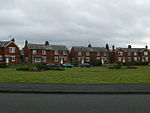Alyn Waters
Country parks in WalesParks in Wrexham County Borough

Alyn Waters (Welsh: Dyfroedd Alun) is a country park situated between Gwersyllt and Llay in Wrexham County Borough, in the north-east of Wales, and is managed by Wrexham County Borough Council.Alyn Waters takes its name from the River Alyn which passes through the park and a footpath runs parallel to the river. There are many paths and trails crossing the park. The park is split in two by the river with one part in Gwersyllt and the other part in Llay. Alyn Waters includes a cafe open all year round on the Gwersyllt side and Llay side has a playground. There is car parking on both sides.
Excerpt from the Wikipedia article Alyn Waters (License: CC BY-SA 3.0, Authors, Images).Alyn Waters
Blast Road, Wrexham Llay
Geographical coordinates (GPS) Address Nearby Places Show on map
Geographical coordinates (GPS)
| Latitude | Longitude |
|---|---|
| N 53.0855 ° | E -3.0087 ° |
Address
Blast Road
Blast Road
LL12 9UG Wrexham, Llay
Wales, United Kingdom
Open on Google Maps





